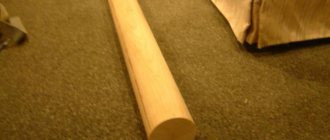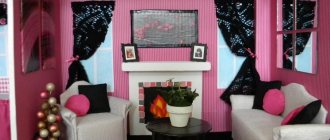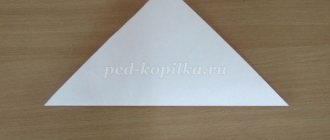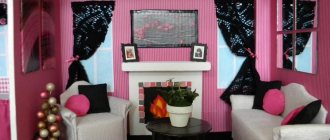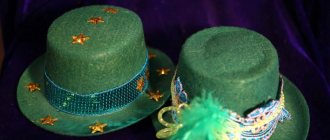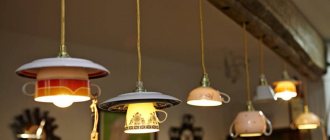Ceiling chandeliers are lighting fixtures that perform two functions simultaneously. Firstly, they are used to organize the main lighting in the room. Secondly, devices are one of the main elements of decorative decoration of a room.
Numerous manufacturers offer equipment of different designs, but it is not always possible to find something truly worthwhile that fits into the overall interior of the room. In other situations, the cost of the chandelier you like may be too high. This is why many people are interested in how to make a ceiling lamp with their own hands.
Hand-made products will be unique and original, thanks to them you can express your taste and character. Making such devices yourself is not so easy. The work requires a certain imagination and perseverance. On the other hand, a ceiling chandelier can be created from improvised means and objects that have become trash for you.
Choose any materials for production - wood, plastic, metal or glass. Chandeliers constructed from wine bottles, wooden skewers or straw look very original. Let's summarize: the choice of material for a homemade lamp depends entirely on the imagination and idea that arose in the head of the apartment owner.
A little about spot lighting
Due to design features, spotlights have a 30-degree lighting vector. That is why one such light source will not be enough for a room, but at the same time, this property allows the lamps to be mounted quite tightly along the entire plane of the ceiling.
In order to fill the room with light, the distance between the lamps should not be more than 100 cm. At the same time, the outermost spots should not be further than 60 cm from the wall. Such indicators are typical for ceilings with a height of 2.5 m, so the installation step should be determined depending on the conditions of your room. The main condition for placing lamps is the intersection of the cones of illumination at a height greater than the bulk of the objects in the room.
Ceiling spotlights can be installed on suspended structures of any configuration. The simplest and most reliable solution would be to install spotlights in a plasterboard ceiling. But the installation procedure is similar for ceilings made of MDF, plastic panels, and aluminum strips.
Lamps in suspended ceilings should only be installed by a professional. This is due to the characteristics of the ceiling surface and the need to use special inserts in places where spots are attached for a stretch ceiling. Such inserts are thermal rings that protect the fabric from stretching and overheating.
In all other cases, spot lighting of ceilings can be organized independently. To do this, you only need tools, certain skills and the desire to create high-quality lighting for your home yourself.
Types of lighting fixtures
The final stage of any repair and construction work will be the purchase of lighting fixtures. Often the main one is a ceiling chandelier, installed in the center of the room, provided its geometry is correct. There is a wide range of lamps on the market, differing in design, shape, principle of operation and even the presence/absence of certain structural elements.
Today, all people want to save money, so it will be important to use a chandelier with energy-saving or LED lamps. It is advisable to choose products with partially or completely closed shades in which the lamps are hidden. Due to this, you will protect the ceiling structure and be able to protect yourself in the event of a light bulb explosion (the fragments will remain inside the lampshade).
If you still like a chandelier with an open arrangement of bulbs, then inspect it and make sure that after installation the light flux will be directed downward. There is also a simple rule - the simpler the product, the easier the subsequent installation.
Another point that should be taken into account when choosing a chandelier is the purpose of the room and its dimensions. In spacious rooms with high ceilings, volumetric pendant lamps should be installed. For small rooms, saving space is required, so focus on flat (flattened) options.
Conventionally, ceiling chandeliers can be divided into two main types:
- classic hanging;
- flat with placement as close as possible to the ceiling.
And the latter are divided into two subcategories - built-in and overhead. Overhead lamps are considered the best solution for bathrooms, corridors and kitchens. The presence of a separation platform ensures their rapid cooling and high fire and electrical safety.
Recessed luminaires are also called spotlights. They are often installed (more correctly, built in) into furniture, suspended ceilings or arched structures. Manufacturers provide a wide variety of shapes, colors and design solutions for both traditional and flat lamps.
Finally, in addition to the design features of the lamps themselves, the type of light sources used is distinguished:
- An incandescent lamp is one of the most common and simple options. The cheapest possible light source. When exposed to mechanical stress, it quickly fails due to the vulnerability of the structure, and burns out relatively quickly (in the case of continuous operation, it can burn out in two or three days).
- An energy-saving fluorescent lamp is one of the best types of housekeepers. The advantages of the product are related to efficiency and long service life. Along with LEDs, it is the most common light source in developed countries.
- An LED lamp is an expensive product, the popularity of which is increasing every year. The efficiency factor exceeds 90%, and in the case of high-quality devices reaches 98%. They are characterized by a longer service life and increased reliability.
Installation of a standard ceiling spot
It is recommended to use the same type of ceiling lamps for each zone. This way you can correctly calculate and purchase the required number of lamps. In this case, it is important to pay attention to the presence of a reflective cone at the base of the incandescent lamp base. For suspended ceilings, it is recommended to use lamps with a power of no more than 40 W, otherwise the ceiling will overheat, which can lead to structural damage or even fire.
LED and halogen lamps must be selected based on power and color spectrum. The wire is selected depending on the ceiling material. So, for example, for drywall, a regular two- or three-core wire VVG-2(3)*1.5 is suitable. For MDF or plastic boards, a fireproof ceiling wiring option is selected. At the same time, it should be soft, each core should appear as many small threads woven under one insulation.
In order to connect the wires and connect lamps to them, you can use special terminal blocks. But it is worth remembering that the bolted connection must be checked twice a year. Otherwise, the contacts on the terminal blocks and wires may become loose, which will lead to overheating and charring of the surfaces.
A more durable and reliable option is fixation using copper or copper sleeves. The connection points are protected with electrical tape or heat-shrinkable tubing (pro
Important characteristics when choosing a wire
It is necessary to take into account the number of cores. In houses where a grounding loop is installed, a 3-wire is used, and where not, a 2-wire is used. Most often, wiring is reconstructed when replacing it in old houses. There is no point in using expensive material there
Pay attention to the type of cable cores, which can consist of 1 conductor or several twisted wires
Having greater resistance, the wire heats up, and as the load increases, the insulation melts or ignites. Therefore, a flexible cable with a non-flammable coating is used.
Correct selection of cable conductor cross-section
Determination of maximum current
From the total power (P) it is easy to obtain the value for the total current: I = P/220 or more precisely from the formula
for a single-phase circuit: P = U * I * cos(φ);
for a three-phase circuit: P = √3 * U * I * cos(φ), where:
U= 220 or 380 V;
Safety factor or power factor: cos(φ) = 1 is taken as the value for household appliances. But the recommended exact value for calculating current supply lines to powerful electrical devices is cos(φ) = 1.3.
Installation procedure
Spot lighting for ceilings is installed in several stages:
- planning;
- wiring;
- forming holes in the ceiling;
- wiring connection;
- fixing the lamps and checking the system.
Why is such a simple task divided into several stages? This is due to the fact that each step is best performed at a certain point in the installation of ceilings.
Advantages and disadvantages
Spotlights have certain advantages and disadvantages. The advantages include the following aspects:
- Organization of partial lighting of the room. Often the entire space is not used, so lighting the entire room will become irrational.
- High-quality light, high brightness, holistic directional light flow.
- Uniform illumination of the room when each lamp is turned on. Due to the uniform installation of the point devices, there will be no dark corners left.
- Preventing the appearance of dark areas. Since the light source is practically located above the head and directs the light flow downward, there are almost no shadows. In addition, in each situation, the beam of rays that emanate from an adjacent device is additionally concealed.
- Economical. Such a device will consume less electricity than, for example, large chandeliers. When LED models are used, the overall savings will be even greater.
- Security of the premises. With small sizes, such devices will not affect the perception of the interior concept.
- Using multi-colored lighting when installing the appropriate lamps.
- Cost savings. A general chandelier with 4-6 shades from a well-known designer will be much more expensive than 8-10 spotlights.
Advantages of spot lighting
However, such equipment also has disadvantages. The main ones:
- Difficult design and installation. Such a system includes many devices, and therefore the design will become more labor-intensive. To connect, you will need to use auxiliary cables.
- When 12-watt lamps are used, you need to use transformers or power supplies.
- Most types of lighting fixtures require a special ceiling design, which is undesirable for low surfaces.
- In a situation where the light becomes excessively hot, the ceiling may be damaged. For example, overheating of halogen light bulbs in suspended ceilings. As a result, polyvinyl chloride loses its appearance.
Important! It is worth noting that there are significantly fewer disadvantages than advantages. Almost every one of them can be eliminated when the installation is done correctly.
Disadvantages of spot lighting
This is interesting: Bathroom lamps - how to choose and which ones are better
Planning
Even before you start covering the ceiling with the chosen material, you need to decide on the placement of the lamps on the ceiling. This is especially true for multi-level suspended structures. Each level is separated into a separate lighting circuit. Do not forget about the recommended distance between lamps.
It is important to distribute all lighting points so that they do not fall on the frame structural elements. Thus, the holes for the spots should be at a distance of at least 3 cm from the frame elements. Otherwise, the profile may interfere with the normal fastening of the lamp using latches.
When distributing lamps, also take into account the installation features of chandeliers or sconces. When using these two types of lighting simultaneously, spotlights can be moved to the sides. You can also create two wiring circuits - for the central chandelier and spotlights.
Parallel
Connecting lamps in parallel is more practical and is used more often than in series. When implementing this method, all light sources will produce the brightness declared by the manufacturer. The only drawback can be considered the increased conductor consumption compared to the previous option.
It is recommended to use VVG ng cable 2x1.5 or 3x1.5. This marking means that two or three wires with a cross-section of 1.5 mm and the cable as a whole have a PVC sheath. The O in the marking indicates that the cable is non-flammable. In some cases, a cable with an additional marking “Is” is used, which means that there is no strong smoke emission when ignited.
Parallel connection of light sources in a daisy chain method
To connect, a cable is pulled from the junction box through the switch, which is connected to each lamp in turn. After the first lamp, the wire is cut and fed to the next one until all devices are exhausted. This scheme guarantees the operation of the circuit even if one of the lamps burns out.
In rooms divided into several functional zones, two groups of lamps are installed. They are usually connected to a two-key switch. This makes it possible to control the inclusion of light, giving it where activity is planned. In this case, you will have to lay the cable separately from each key to a specific group of lamps. In general, the principle of such a scheme is no different from the description in the paragraph above.
Wire distribution
At the stage of forming the ceiling frame, it is necessary to distribute the wires and secure them so that when drilling holes for the lamps they can be easily reached. As a last resort, you can stretch the wire to the first hole, and for the remaining lamps the wire will be threaded from hole to hole. However, this method has a significant drawback - you will not be able to attach the wires to the frame, that is, they will simply lie on the ceiling material.
With the usual method of wiring distribution, the wire is laid according to a certain pattern to the places where the lamp is installed, leaving 10-15 cm of wire at each point. The wiring is secured to the frame using plastic ties. But do not tighten them too much, as the wires tend to change their length when heated. Now you can begin installing the suspended ceiling.
Options for assembly and repair of LED lamps
When starting independent work, you must remember that this is fraught with risk, because the voltage of 220 V is dangerous to life. And everything you have to do is done at your own peril and risk.
Option one
To work with this option, you need basic knowledge of electrical engineering, the ability to use a soldering iron and a multimeter. For the source material, you can use a faulty LED lamp.
How to proceed:
- Separate (the choice of method is arbitrary) the bulb from the base, which already contains a source for controlling the LEDs (driver).
- Inspect the board with LEDs. If a black dot is detected on a semiconductor, remove it from the board and solder a new one.
This option is more suitable for assembling a LED ceiling lamp with your own hands.
Note!
DIY country washbasin - review of simple and complex designs (97 photos of the best ideas)
How to make a garden (construction) wheelbarrow with your own hands: detailed instructions with description + 85 photos of fresh ideas
- How to make a bench with your own hands - 90 photos of the best ideas from the master. Review of finished drawings, diagrams and dimensions of the bench
Option two
The circuit is simple, without an additional power supply, but an electric shock cannot be ruled out, because all the elements are without insulation, so very careful insulation is required.
- circuit layout;
- 100 Ohm resistor;
- powerful diode rectifier;
- 400pF capacitor with a voltage rating of at least 350V;
- smoothing capacitance of 10 µF.
Third option
Solder at least 60 LEDs in series and connect them to a 220V network via a diode bridge. These are typical options for making a 220V LED lamp with your own hands.
Fourth option
The simplest way, but more interesting in design terms. Assembly requires not home-made elements, but industrial ones:
- LED Strip Light;
- Industrial power supply (see above in the text).
Forming holes for lamps
So, you have a project, but you can still finally determine the position of the lamps only after the ceiling has been completely covered. At this stage, it is important to take into account the location of the seams between the individual sheets of suspended ceiling material. If the installation point of a spotlight for a suspended ceiling is at a joint, then it must be moved to the side.
The hole for the lamp is made using a special wood crown. With its help, it is possible to create perfectly even holes, which has a positive effect on fixing the lamp. Moreover, such a crown perfectly makes a hole both in MDF ceiling panels and in plasterboard or plastic.
The diameter of the hole is selected according to the size of the lighting fixtures. Its size should be 3-4 mm smaller than the outer diameter of the front part of the lamp, but larger than the inner part of the spot. Therefore, the hole width often ranges from 60-75 mm.
Before drilling into the ceiling, think again. Make sure the location of the lamp is correct and only then start drilling.
Installation of spotlights, detailed video instructions:
Style selection
In addition to the points listed in the first chapter of the article, when choosing a chandelier you need to focus on a specific style. This is also true for those cases when you decide to make the product yourself. Comfort, coziness and how pleasant it will be to be in it depend on the interior created in the room.
The ceiling chandelier is the main element of decor, therefore, with a competent approach, the perception of the environment will improve, but with a careless approach, it will completely deteriorate. As you know, “breaking is not building”, therefore, to ruin the interior, it is enough to choose the wrong style.
Decide in advance on the design of the future lamp. The most common styles for chandeliers are high-tech, modern and Provence.
High tech
This includes products made of glass and metal. Modern appliances fit perfectly into the design of the bedroom and living room. Externally, the chandelier may look chaotic (with a random arrangement of decorative elements). An excellent option for people who want to modernize an apartment or private house, but do not want to make something too complicated. Any errors made during the manufacture of the chandelier may look like an original design solution.
Modern
In accordance with this style, devices are made of glass and wood. The ceiling lamp is characterized by perfectly smooth and clear lines and has the correct geometry.
Provence
The most complex design, which is suitable for people who understand the principles of hand-made. Various fabrics, colorful ribbons, beads, and embroidery can be used to decorate a chandelier. The lamps are delicate and suitable for creating a romantic atmosphere. A Provence style lighting fixture is suitable for decorating any living space.
Connection
After you make all the holes, the loops of wires come out (those 10-15 cm that you left). If you chose the second method of laying wires, then now is the time to stretch the wire from hole to hole.
Remember that before starting any wiring work, you must disconnect the power to the appropriate wire.
The wire loops are cut along the bend and exposed. To connect each lamp, wiring 10-12 cm long is used. Having exposed 10-15 mm of wire on each side, the ends are clamped into the terminal on the lamp and connected to the supply wire. In this case, it is necessary to observe the markings on the lamp. So, wire L is phase, N is zero, PE is ground. They may have different braid colors, so check each wire with an indicator screwdriver or tester just in case.
An example of a homemade lamp
Let's look at one of the simplest examples of a DIY ceiling lamp.
For production we will need:
- plastic bottle 5 l;
- plastic spoons - their number depends on the size of the bottle that will become the frame;
- quick-drying glue for plastic;
- sharp knife;
- cartridge with wire.
First, prepare a frame from a plastic bottle. Remove any labels from the item, rinse it and dry thoroughly. After this, feel free to cut out the bottom. Cut off all the handles from the plastic spoons, but so that small pieces of 2 cm remain.
Glue the resulting scraps with “scoops” onto the base of the frame made from a plastic bottle. To do this, we just need the remaining pieces of the handles, which need to be poured generously with glue and pressed tightly to the surface (the convex part of the scoop should face outward). Cover the container in a circle until the entire surface is hidden. Ideally, the spoons are placed in a checkerboard pattern and then shifted to ensure a tight fit and no visible areas.
The sockets with wiring can be removed from an old chandelier, then installed and fixed in a new product by pulling it through the neck of the bottle. A decorative bowl can be decorated with the same blanks using glue and placing them on the neck.
To make sure the product is working, at the final stage, screw a light bulb into the lamp and connect it to the power source. If successful, all that remains is to install the chandelier on the ceiling.
For a more stylish design and change of colors, you can paint plastic spoons. This will increase the originality and attractiveness of the product.
Consolidation
Most spotlights have brackets on the sides. They are bent upward until it stops. In this position, the lamps are inserted into the hole. Be careful not to allow the wires to get caught under hooks. After you insert the lamp, the hooks independently press against the ceiling, thereby holding the spot on the surface (read: “Inserting on a suspended ceiling”).
After installing all the elements, you can connect the lighting system to the main power wire on the junction box, step-down power supply or switch. At this point, the work on installing a spot lighting system can be considered complete.
As you can see, there is nothing difficult in installing spotlights in the house. You can see the results of such work in the photo. Using lamps of different colors and brightness, you can highlight certain decorative elements or divide the room into functional zones.
Requirements
The lamps, fixed at the same level with the ceiling surface, according to their technological parameters, have a 30-degree lighting angle. Therefore, to create brightness, they must be installed at intervals of up to a maximum of 1 meter, and the distance from the last lamp should not exceed 60 cm to the wall. Provided that the ceiling height in the room is standard - 2.5 meters.
To create sufficient brightness for lighting the room, preliminary calculations are made so that the intersection of the corners of each spot is at a certain height, taking into account the height of the furniture and the configuration of the suspended ceiling.
First of all, choose the material
So, let's see what we have to make the future lamp from. You can use what you have on hand or go to the fair and buy something special - it's up to you.
As the base of a floor lamp, you can use a ready-made structure and simply decorate it with new elements, or make everything yourself from the very beginning. Start the project with a clear idea of the trajectory you will take.
Any floor lamp has three main design elements:
- Shade – performs two functions simultaneously. Firstly, it protects the eyes from direct light by absorbing or reflecting rays on its surface. Secondly, it creates a directed flow of light to the right place, due to which the room is filled with soft lighting. Using translucent plastic or fabric, you can achieve light of any shade. Any material is perfect, including metal and paper. The lampshade has a frame, which is most often made of steel wire. A frameless design is assumed only if the lampshade is made from threads.
- Rack – referred to as the leg of the lamp. In our case, we can use absolutely any materials. An old tripod (it will then serve as a base), a metal pipe, wooden tripods, tree branches, antique large vases and jugs, any imaginary designs, whatever your soul and imagination desires may be perfect.
- Base – this is the place where the lamp touches the floor surface; it can be movable or stationary, collapsible or solid, and have one or more points of contact. The choice of base is tied to the location of future installation. It can be made visually motionless or, conversely, given grace and made floating in a modern style.
How to make a moon lamp out of paper with your own hands
Shot: @Crafts Junction / YouTube
What do you need
- Paper napkins, towels or toilet paper;
- PVA glue;
- water;
- brush;
- plastic ball;
- White paint;
- black paint;
- sponge;
- lamp base;
- plastic bucket with lid;
- glue gun;
- knife;
- bulb;
- pencil;
- wire.
How to do
Separate napkins, towels or toilet paper into single-layer pieces. Start gluing them to the ball by coating it with glue lightly mixed with water. Place the pieces of paper on top of each other and also coat the top with glue.
Shot: @Crafts Junction / YouTube
Thus, glue the entire ball in several layers. Dry the paper completely.
Shot: @Crafts Junction / YouTube
Cover the figure with white paint and let dry. Mix white paint with a little black to create a gray color. Use a sponge to make gray spots on the ball.
Shot: @Crafts Junction / YouTube
Glue the lamp base to the back of the cover using hot glue. Cut a large hole in the bottom of the bucket. Connect the lid and bucket and screw in the light bulb.
Shot: @Crafts Junction / YouTube
Draw a circle on the ball with a pencil. You can circle a glass or some other object. Cut along the marked line and remove the plastic.
Shot: @Crafts Junction / YouTube
Place the ball on the light bulb. For reliability, you can glue the figure to the base.
Connection diagrams for 220 V
Some spotlights operate on a 12 V network. In this case, special step-down transformers (drivers) are required. Recently, a huge number of spots have appeared that operate from a 220 V industrial network. To a certain extent, the former are considered safer, but the installation and connection of the latter is much simpler.
Serial connection
The simplest scheme to implement, requiring a minimum amount of materials. Spots are connected sequentially one after another, but it is advisable that their number does not exceed five or six pieces. Due to the serial connection, interruptions in lighting may occur, and if one lamp fails, the circuit will break and the others will stop working. To restore the functionality of the circuit, you will have to disassemble it and check each spot separately.
To implement it, you need to connect the phase from one lamp to another, and connect the neutral wire to the latter. The phase is pre-supplied to the switch, which guarantees its functionality.
If you want to connect triple wiring, you need to connect the ground wire to each lamp by finding the appropriate terminals. Grounding can be done through the nearest outlet or switch.
Parallel connection diagrams
The approach is much more complicated than the previous one. There is a dependence: the more connected spots, the higher the cost of organizing lighting and time costs. On the other hand, when connecting each lamp separately, they will shine with the same intensity stated in the passport. Therefore, despite the difficulties, the current method is considered the most popular and widespread.
Parallel connection is implemented in two options:
- Beam method - each lamp has a separate pair of wires.
- Daisy chain connection - two wires are connected to the lamps alternately, and then fed from the output.
Radial
The approach is the most complex, since a separate luminaire requires its own cable. The advantage is high reliability. If it fails, only the damaged spot will stop lighting. To implement the method, take the cable connected to the junction box and stretch it to the middle of the room. Secure using various elements, from here pull separate pieces for each recessed lamp.
Pay attention to safety as there are several wires radiating from one location. If a single-core cable is selected and a small number of spots are connected, the wiring is carried out using the twisting method, crimping with pliers and additional welding
The connection will be permanent. Another option is simpler: each conductor should be equipped with connectors that are inserted into the terminal block slot.
Daisy chain connection
The cable comes from the junction box and connects to the first lamp. Next, you need to take a piece of another wire and connect it to the output of the device, and the other end should be connected to the next spot. Repeat the steps for all spots until the circuit is connected.
The lamps will operate from one switch. If you need to divide them into two groups, then the connection should be made through a two-key switch. The circuit becomes slightly more complicated due to an increase in the number of cables. It is possible to install a backlit switch.
How to connect spotlights
In order to connect spotlights, many use a special plinth, which has recently been especially often installed with suspended ceilings. You can also do a simple installation. Installing lamps is not a difficult task; it can be easily done independently, without the help of a specialist. To begin with, before installing the suspended covering, it is necessary to prepare the base ceiling surface, that is, by marking the places for installing devices, strengthen the consoles.
When the material for the ceiling covering has already been finally installed, holes for the lamp are made in its surface. Most often, plasterboard sheets are used for suspended ceilings, which can be very easy to cut. The dimensions for lamps are usually very easy to determine: usually the diameter is indicated on the packaging of the spotlight. Most often, the average dimensions of such a lamp are from sixty to seventy millimeters.
After this, cables should be laid into each of the holes on the surface of the suspended ceilings, which are then connected to the terminals of each device.
To install, the springs of the spotlight are brought together, inserted into the hole prepared in advance, and then released. As soon as they take their immediate position, the lamp itself is pressed tightly against the surface of the suspended ceiling. No tags for this post.
